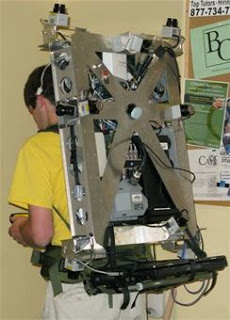Ad Support : Nano Technology Netbook Technology News Computer Software
A portable, laser backpack for 3D mapping has been developed at the University of California, Berkeley, where it is being hailed as a breakthrough technology capable of producing fast, automatic and realistic 3D mapping of difficult interior environments.
The backpack is the first of a series of similar systems to work without being strapped to a robot or attached to a cart. At the same time, its data acquisition speed is very fast, as it collects the data while the human operator is walking; this is in contrast with existing systems in which the data is painstakingly collected in a stop and go fashion, resulting in days and weeks of data acquisition time. Using this technology, Air Force personnel will be able to collectively view the interior of modeled buildings and interact over a network in order to achieve military goals like mission planning.
The scientists have been able to use this more portable method of mapping by way of sensors or lightweight (less than eight ounces) laser scanners.
“We have also developed novel sensor fusion algorithms that use cameras, lasers range finders and inertial measurement units to generate a textured, photo-realistic, 3D model that can operate without GPS input and that is a big challenge,” said Zakhor.
There are many basic research issues to achieve a working system, including calibration, sensor registration and localization. Using multiple sensors facilitates the modeling process, though the data from various sensors do need to be registered and precisely fused with each other in order to result in coherent, aligned, and textured 3D models. Localization is another technical challenge since without it; it is not possible to line up scans from laser scanners in order to build the 3D point cloud, which is the first step in the modeling process.
“It is fair to say that embarking on such a hands-on project, to make indoor 3D modeling a matter of routine, a number of research questions of a fundamental nature came up,” said Sjogren. “It is typical of the work that Prof. Zakhor has done for AFOSR/Air Force Research Laboratory over the years, that she meets these challenges head-on, and in most cases solves the problem sufficient to demonstrate a prototype system.”
If you liked this article, please give it a quick review on Reddit, or StumbleUpon. Thanks
Supporting Advertising
Business Success
How to Make Money
Executive Jobs
Paid Surveys
Thank You

Brian Wang is a Futurist Thought Leader and a popular Science blogger with 1 million readers per month. His blog Nextbigfuture.com is ranked #1 Science News Blog. It covers many disruptive technology and trends including Space, Robotics, Artificial Intelligence, Medicine, Anti-aging Biotechnology, and Nanotechnology.
Known for identifying cutting edge technologies, he is currently a Co-Founder of a startup and fundraiser for high potential early-stage companies. He is the Head of Research for Allocations for deep technology investments and an Angel Investor at Space Angels.
A frequent speaker at corporations, he has been a TEDx speaker, a Singularity University speaker and guest at numerous interviews for radio and podcasts. He is open to public speaking and advising engagements.


